
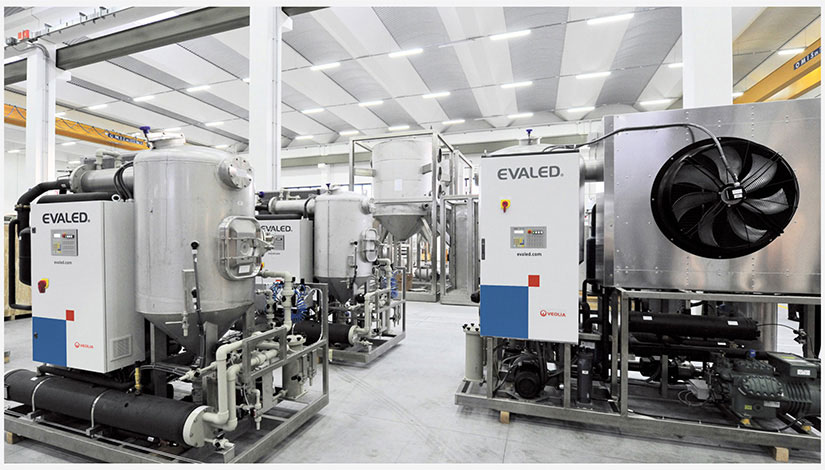
A brief compendium of EVALED® laboratory analysis competences
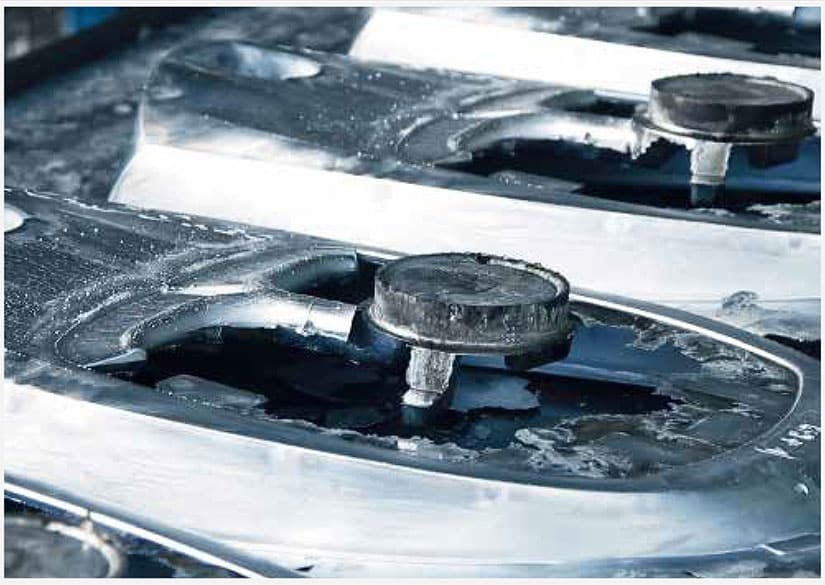
Mechanical and surface processes that involve the automotive, aviation, furniture, and appliances industries require large quantities of water and produce highly pollutant wastewater that cannot be discharged directly into the sewer without proper treatment. This requirement can easily increase a company’s operating costs.
Waste Typology: Oil emulsion containing coolant from machine tools and rinsing water of metal components from washing machines.
Results (PC F-AA)
In the laboratory evaporation test, a distillation yield of 90% was reached, meaning the waste was concentrated about 10 times. Normally, productivity will decrease according to the rise in boiling point. This value was strictly correlated to solution characteristics. The presence of volatile organic substances may involve the development of incondensable vapors that may cause problems to the vacuum system. During distillation, the liquid produced a considerable foam. It was necessary to check the foam to avoid dragging in distillate. At this yield, some fouling could appear inside the heat exchanger, so more frequent maintenance may be needed in order to maintain unit performance.
Materials
The waste was slightly alkaline and contained a small amount of chlorides. To guarantee good corrosion resistance, the austenitic steels of the AISI 316 series must be used for the parts of the unit that are exposed to the waste.
Evaporator Type According to:
PRAB recommends using a forced circulation vacuum evaporator with a SHELL-AND-TUBE HEAT EXCHANGER, powered by a heat pump.
It is also possible to use other installation types (immersed coil heat exchanger or plate heat exchanger with a SCRAPING SYSTEM, etc.) powered by steam/hot water or by thermocompression.
These options require redefining the following parameters:
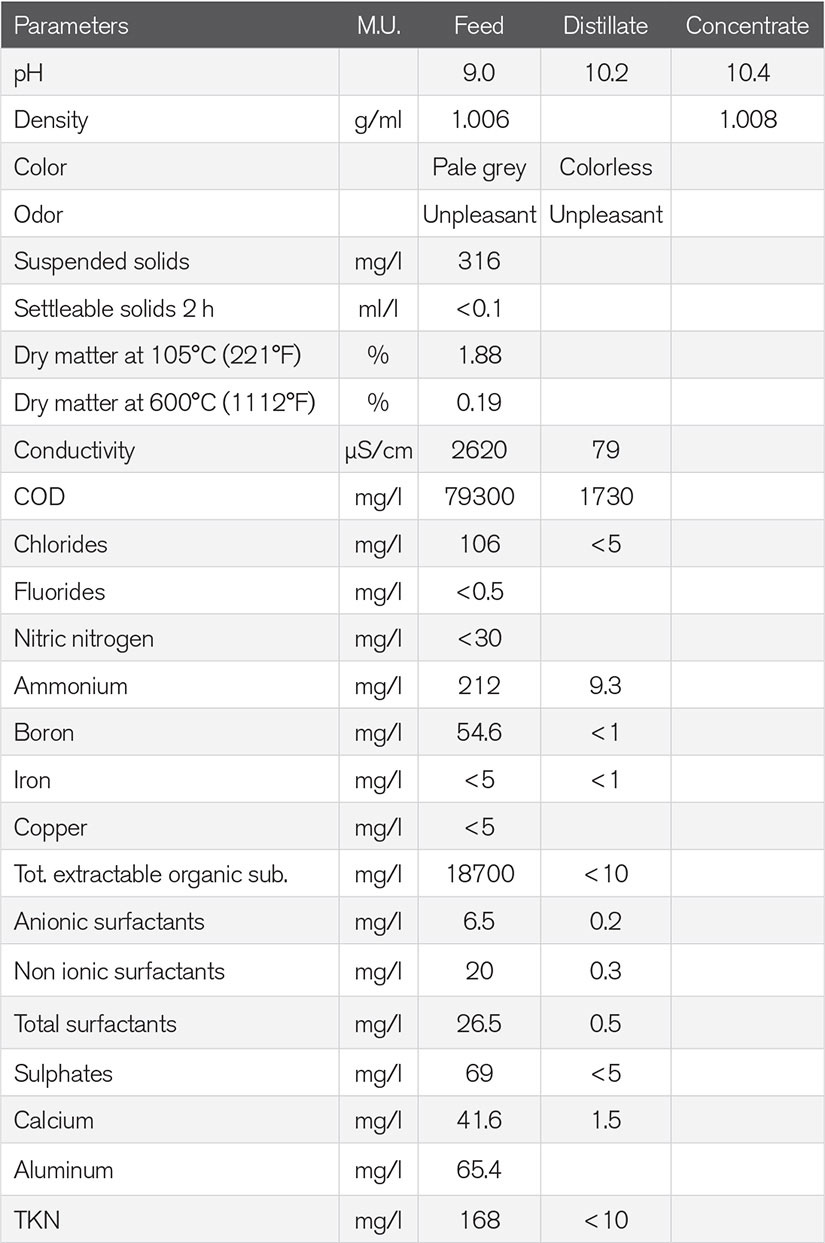
Waste Typology: Oil emulsion containing coolant from machine tools and rinsing water of metal components from washing machines.
NOTE: The distillate and the concentrate were obtained by vacuum evaporating the waste. The recommended yield for a SHELL-AND-TUBE HEAT EXCHANGER (Type PC F) is: 89-91%.
Waste Typology: Oil emulsion from diesel engine manufacturing. Sample named Multan B 204 (Henkel).
Results (PC F-AA, PC F-AA with Yield< 88%)
In the laboratory evaporation test, a distillation yield of 93% was reached, meaning the waste was concentrated 14 times. Normally, productivity will decrease according to the rise in boiling point. This value was strictly correlated to solution characteristics. The presence of volatile organic substances may have involved the development of incondensable vapors and may have caused problems to the vacuum system. During the distillation process, the liquid produced a moderate foam. It was necessary to check the foam to avoid dragging in the distillate.
Materials
The waste was slightly alkaline and contained a small amount of chlorides. To guarantee good corrosion resistance, the austenitic steels of the AISI 316 series must be used for the parts exposed to the waste.
Evaporator Type According to:
PRAB recommends using a vacuum evaporator with a SCRAPING SYSTEM, powered by a heat pump.
It is also possible to use other installation types (forced circulation with a SHELL-AND-TUBE HEAT EXCHANGER, immersed coil heat exchanger, or plate heat exchanger, etc.) powered by steam/hot water or by thermocompression.
These options require redefining the following parameters:
By working with lower concentration factors (distillation yield lower than 88%), it is possible to use a vacuum evaporator with a SHELL-AND-TUBE HEAT EXCHANGER, powered by a heat pump.

Waste Typology: Water from surface treatment with potassium ferrocyanide.
NOTE: The distillate and the concentrate were obtained by vacuum evaporating the waste.
*Indicative value for the nature of the sample. The recommended yield for a SHELL-AND-TUBE HEAT EXCHANGER (Type PC F) is 85-88%. The recommended yield for a scraped heat exchanger evaporator (Type PC R) is: 92-94%

All the effluents used in the production process can be reused a second time for water saving and matter recovery (when needed).
Waste Typology: Reactor washwater from coffee sweets production.
Results (RV F-AA)
In the laboratory evaporation test, a distillation yield of 95% was reached, meaning the waste was concentrated about 20 times. Normally, productivity decreases according to the rise in boiling point. This value was strictly correlated to solution characteristics. The wastewater had a quantity of settleable solids: A sedimentation before evaporation could be advised.
The wastewater had a large quantity of suspended solids: A pretreatment before evaporation could be advised. We recommend the metering of an anti-scaling compound to limit the scaling phenomena, as well as frequent maintenance operations.
Materials
Before the distillation test, the pH of the waste was corrected at a value of 8.1 with sodium hydroxide 32%. After pH adjustment, the waste contained a considerable amount of chlorides. To guarantee good corrosion resistance, the austenitic steels of the AISI 316 must be used for the parts exposed to the waste. In order to avoid corrosion problems on the upper parts of the evaporator, it is necessary to use the INOX series for the BLOWER.
Evaporator Type
According to:
PRAB recommends using a forced circulation vacuum evaporator with a SHELL-AND-TUBE HEAT EXCHANGER, powered by Mechanical Vapor Recompression.
It is also possible to use other installation types (immersed coil heat exchanger, plate heat exchanger with a SCRAPING SYSTEM, etc.) powered by steam/hot water or by thermocompression.
These options require redefining the following parameters:

Waste Typology: Reactor washwater from coffee sweets production.
NOTE: The distillate and the concentrate was obtained by vacuum evaporating the waste after having raised its pH to 8.1 by adding about 2 ml of sodium hydroxide 37% w/w to one liter of waste. The recommended yield for a SHELLAND- TUBE HEAT EXCHANGER evaporator (Type RV F) is: 94-96%.
Waste Typology: Reactor washwater containing sugar from sweets production.
Results (RV F-AA)
In the laboratory evaporation test, a distillation yield of 85% was reached, meaning the waste was concentrated about 6 times. Normally, productivity decreases according to the rise in boiling point. This value was strictly correlated to solution characteristics.
Materials
Before the distillation test, the pH of the waste was corrected at a value of 6.5 with sodium hydroxide 32%. After pH adjustment, the waste contained a small amount of chlorides. To guarantee good corrosion resistance, the austenitic steels of the AISI 316 must be used for the parts exposed to the waste. In order to avoid corrosion problems on the upper parts of evaporator, it is necessary to use the INOX series for the BLOWER.
Evaporator Type
According to:
PRAB recommends using a forced circulation vacuum evaporator with a SHELL-AND-TUBE HEAT EXCHANGER, powered by Mechanical Vapor Recompression.
It is also possible to use other installation types (immersed coil heat exchanger, plate heat exchanger with a SCRAPING SYSTEM, etc.) powered by steam/hot water or by thermocompression.
These options require redefining the following parameters:
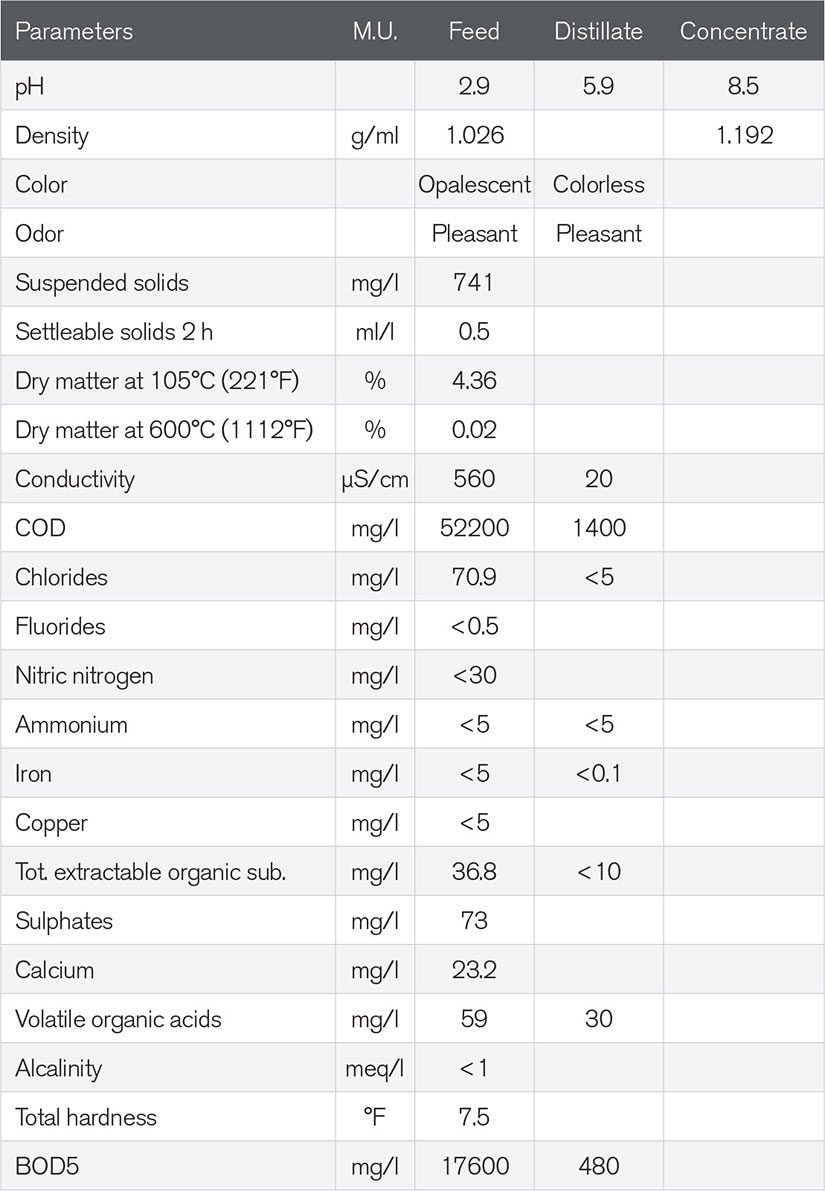
Waste Typology: Reactor washwater containing sugar from sweets production.
NOTE: The distillate and concentrate was obtained by vacuum evaporating the waste after having raised its pH to 6.5 by adding about 2 ml of sodium hydroxide 32% w/w to one liter of waste. The distillate and the concentrate was obtained by vacuum evaporating the waste. The recommended yield for a SHELL-AND-TUBE HEAT EXCHANGER evaporator (Type RV F) is: 83-85%.

The oil and gas industry faces specific water and wastewater treatment challenges.
EVALED® evaporators represent an effective solution for both downstream (onshore and offshore) and upstream plants, allowing ZLD (Zero Liquid Discharge).
Waste Typology: Fracking wastewater from drilling.
Results (AC F-FF)
In the laboratory evaporation test, a distillation yield of 70% was reached, meaning waste was concentrated about 3 times. Normally, productivity decreases according to the rise in boiling point. This value was strictly correlated to solution characteristics. The presence of volatile organic substances may involve the development of incondensable vapors that may cause problems to the vacuum system. PRAB suggests the metering of an anti-scaling compound to limit the scaling phenomena, as well as frequent maintenance operations. The concentrate has the tendency to solidify; therefore, it was necessary to discharge it before the stand-by period. During the distillation process, the liquid produced a considerable foam. It was necessary to check the foam to avoid dragging in the distillate. The wastewater had some quantity of settleable solids: A suitable sedimentation before evaporation can be advised.
Materials
The waste was practically neutral and contained a very high amount of chlorides. To guarantee good corrosion resistance, a duplex steel (UNS S32750/S32760) must be used for the parts exposed to the waste.
Evaporator Type
According to:
PRAB recommends using a forced circulation vacuum evaporator with a SHELL-AND-TUBE HEAT EXCHANGER, powered by hot/cold water.
It is also possible to use other installation types (immersed coil heat exchanger, plate heat exchanger with a SCRAPING SYSTEM, etc.) powered by steam/hot water or by thermocompression.
These options require redefining the following parameters:

Waste Typology: Fracking wastewater from drilling.
NOTE: The distillate and concentrate was obtained by vacuum evaporating the waste. The recommended yield for a SHELL-AND-TUBE HEAT EXCHANGER evaporator type AC F is: 65-70%.
Waste Typology: Fracking wastewater from drilling.
Results (PC R-FF or PC F-FF with Yield< 88%)
In the laboratory evaporation test, a distillation yield of 93% was reached, meaning the waste was concentrated about 14 times. Normally, productivity will decrease according to the rise in boiling point. This value was strictly correlated to solution characteristics. At this yield, some fouling may appear inside the heat exchanger, so maintenance operations will have to be more frequent in order to maintain unit performance. We recommend the metering of an anti-scaling compound to limit the scaling phenomena, as well as frequent maintenance operations. The wastewater has a large quantity of settleable solids: A pretreatment before evaporation can be advised.
Materials
The waste was practically neutral and contained a very high amount of chlorides. To guarantee good corrosion resistance, a duplex steel SAF 2507 (UNS S32750) must be used for the parts exposed to the waste.
Evaporator Type
According to:
PRAB recommends using a vacuum evaporator with a SCRAPING SYSTEM, powered by a heat pump.
It is also possible to use other installation types (forced circulation with a SHELL-AND-TUBE HEAT EXCHANGER, immersed coil heat exchanger, plate heat exchanger, etc.) powered by steam/hot water or by thermocompression.
These options require redefining the following parameters:
By working with lower concentration factors (distillation yield lower than 88%) it is possible to use a vacuum evaporator with a SHELL-AND-TUBE HEAT EXCHANGER, powered by a heat pump.
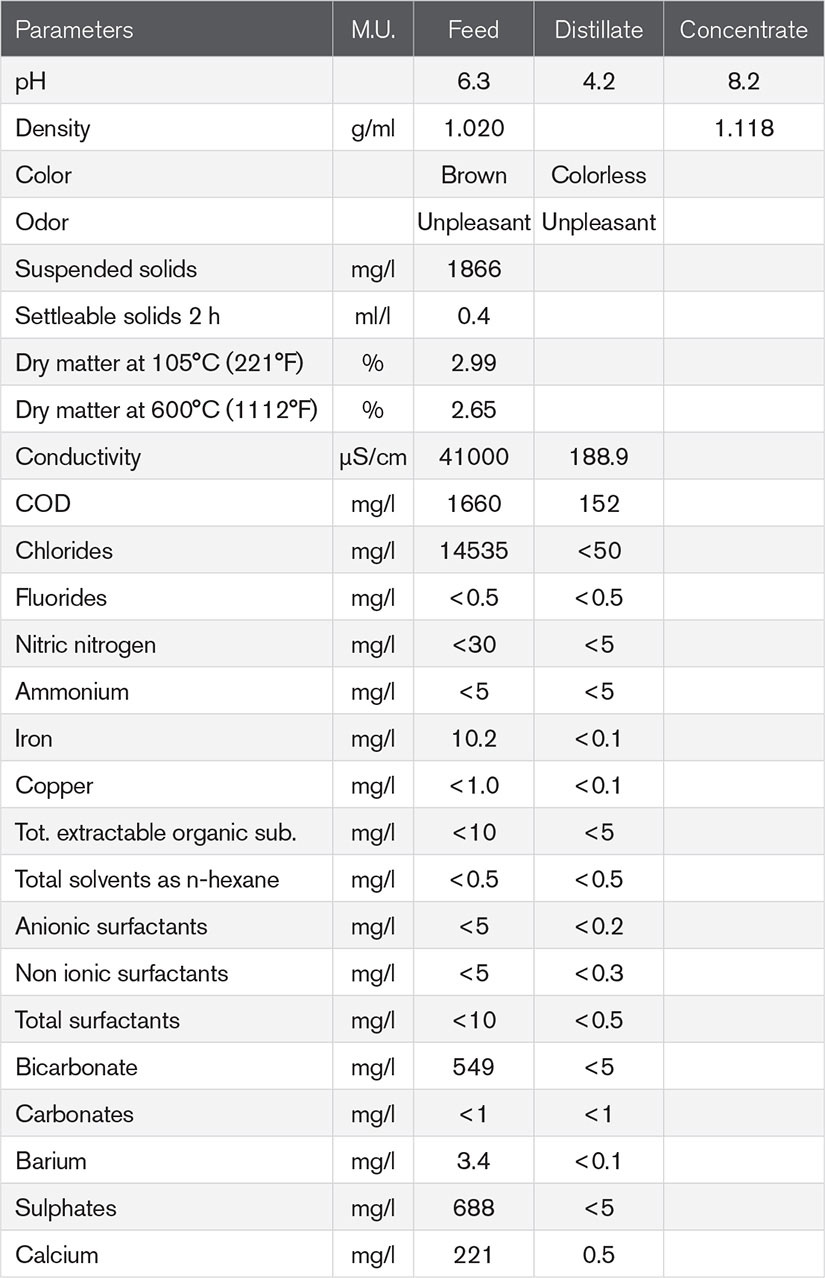
Waste Typology: Fracking wastewater from drilling.
NOTE: The distillate and the concentrate was obtained by vacuum evaporating the waste. The recommended yield for a SHELL-AND-TUBE HEAT EXCHANGER evaporator (Type PC F) is: 88-90%. The recommended yield for a scraped heat exchanger evaporator (Type PC R) is: 91-93%.